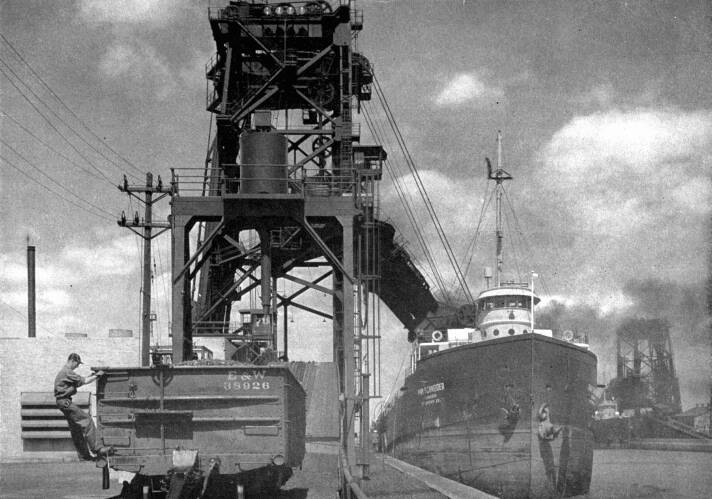 Dumping Coal from Cars into Ships
Dumping Coal from Cars into Ships
A never-ending stream of coal flows by various rail routes
from our coal mines to our seaports and lake-ports. At these ports
the coal is loaded into steam vessels—some for reshipment
to American ports, some for export to foreign lands, some to fuel
the ships that carry on our sea-borne commerce.
At many of these ports, the railroads own and operate great
coal storage yards large enough to hold thousands of coal cars
at one time. To stand on a bridge or other elevation and look
out over one of these huge yards with its acres and acres of cars
laden with coal is a sight one will never forget.
But the most impressive spectacle of all at one of these coal
terminals is the towering mechanism by which the coal is unleaded
from the cars into the holds of the ships. Some railway coal terminals
are equipped with two or three coal dumping machines, each capable
of unloading from 40 to 60 cars an hour.
Described by one writer as "an inspiring spectacle of
engineering wizardry," the electrically-operated mechanical
unloader, similar to the one in the picture, grips the largest
coal car, fully loaded, lifts it 50 to 75 feet or more above the
track structure, dumps its contents into the coal "pan"
leading to the ship's hold, and returns the car to its original
position. Some unloading machines are capable of performing all
of these things in less than a minute.
By this method a ship of 10,000 tons capacity can be loaded
in two and one-half hours.
Ocean-going ships engaged in coal trade have an average capacity
of about 5,000 tons, although there are some which carry upwards
of 10,000 tons. Some of the coal-carrying vessels on the Great
Lakes range from 10,000 to 15,000 tons capacity.
A carload of coal comes from the mines, perhaps hundreds of
miles away, on a regular waybill. When the car arrives at the
port terminal, the waybill is checked by yard clerks, and the
car is switched to a track containing cars loaded with a similar
grade or brand of coal. The number of the car is recorded on sheets
held by the yardmaster and the coal pier offices.
Now, suppose a ship has just arrived at the port to be loaded
with this particular grade of coal. The yardmaster issues instructions
to a yard crew to deliver this and other cars containing the same
grade of coal to the gravity load yard, or "barney yard."
There a crew releases the cars as they are wanted for unloading.
When released the car drifts by gravity down the tack to the scales
where it is weighed automatically. The weight is checked by the
sale clerk and transmitted by "telautograph" to the
office on the pier, where the car number and weight is checked
again before dumping. Then a narrow-gauge electric locomotive,
known as a "barney," or "mule," moves the
car up the incline track to the unloader. When it is in its proper
position beneath the steel structure it is gripped firmly by the
giant unloading machine, lifted up to the "pan," turned
over as easily as a boy would turn a glass of milk, dumped, and
set back on the track, where it rolls off by gravity and comes
to a halt in the empty yard. When dumped into the "pan,"
the coal slides down a huge adjustable telescopic chute into the
hold of the ship.
At some coal piers cars are lifted by elevators to tracks 50
or 75 feet or more above the pier floors and dumped into "pans"
through hoppers in the bottoms of the cars. Piers equipped for
handling cars in this manner sometimes have several chutes enabling
several cars to be "spotted" and dumped at the same
time and enabling two or more vessels to be loaded simultaneously.
While the work of transferring coal from cars to ships is in
progress on the pier, a staff of checkers and office workers are
busy keeping tally sheets and records of coal in the yard, coal
moved to unloaders, coal dumped, coal on the way from the mines,
coal stored, coal classified, coal weighed, empty cars returned,
demurrage charges, and so on.
Controlling the movement of the coal from the gravity yard
to the ship's hold are several operators who maintain constant
communication with each other by telephone, loudspeakers and push-button
signals.
Car dumping machinery of this kind is also used for loading
ores, sand and gravel, sulphur, and other heavy bulk commodities
into vessels.
I've Been Working
on the Railroad | Contents Page
|







